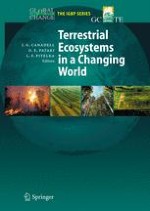2007 | OriginalPaper | Buchkapitel
Plant Species Migration as a Key Uncertainty in Predicting Future Impacts of Climate Change on Ecosystems: Progress and Challenges
verfasst von : Guy F. Midgley, Wilfried Thuiller, Steven I. Higgins
Erschienen in: Terrestrial Ecosystems in a Changing World
Verlag: Springer Berlin Heidelberg
Aktivieren Sie unsere intelligente Suche, um passende Fachinhalte oder Patente zu finden.
Wählen Sie Textabschnitte aus um mit Künstlicher Intelligenz passenden Patente zu finden. powered by
Markieren Sie Textabschnitte, um KI-gestützt weitere passende Inhalte zu finden. powered by
As we show above, a failure to incorporate migration limitations into models of vegetation response to climate change greatly compromises their predictive capability, and the uncertainty due to migration is therefore substantial. Species range shifts have been a ubiquitous response by plant species during Pleistocene climate change, and early signs of this response are evident in modern assemblages. Recent work has increased our understanding of the dispersal limitations to migration rate, but there has been far less focus on the issues which govern population establishment and growth rate, especially at the edge of species’ ranges.
An overall understanding of community responses to climate change would also benefit from better understanding of
in situ
adaptive responses, as these appear to be significant in some species. Much has been learned from reconstructions of past migration patterns in the paleo-record, and from studies of alien invasive plants, but these “natural experiments” are limited in that they represent special cases where species migration occurs over landscapes unfragmented by human activities (paleo- record), or are experiencing release from predators and pathogens (alien species).
Finally, promising approaches are being developed that address the issue of how human transformation of landscapes will modify migration rates, and that combine mechanistic migration models with spatially explicit models of species geographic ranges at spatial scales relevant to simulating plant propagule dispersal and demographic behavior. These approaches will provide useful insights into biodiversity change under climate and landuse change scenarios. However, the potential increase in spatial resolution of DGVM simulations, and their increasing capacity to simulate more finely defined plant functional types, will allow them to provide an independent alternative assessment of the role of migration in determining the future structure and function of the ecosystems of the Earth.
